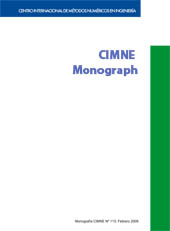Numerical Modeling of Crack Formation in Powder Compaction Processes
FREE!
ISBN: 978-84-96736-79-5
Editorial: CIMNE
Year of publication: 2009
Pages: 247
Index: Introduction; Continuum modeling of the powder behavior; Integration of the constitutive equation; Numerical assessment; Modeling guidelines for industrial applications: compaction of a multilevel part; Concluding remarks; Mathematical aspects of the continuum formulation; Analytical study of the compaction of a cylindrical specimen; Thermodynamic aspects; References
ISBN: 978-84-96736-79-5
Editorial: CIMNE
Year of publication: 2009
Pages: 247
Index: Introduction; Continuum modeling of the powder behavior; Integration of the constitutive equation; Numerical assessment; Modeling guidelines for industrial applications: compaction of a multilevel part; Concluding remarks; Mathematical aspects of the continuum formulation; Analytical study of the compaction of a cylindrical specimen; Thermodynamic aspects; References
Description
Powder metallurgy (P/M) is an important technique of manufacturing metal parts
from metal in powdered form. Traditionally, P/M processes and products have
been designed and developed on the basis of practical rules and trial-and-error
experience. However, this trend is progressively changing. In recent years, the
growing efficiencies of computers, together with the recognition of numerical simulation
techniques, and more specifically, the finite element method , as powerful
alternatives to these costly trial-and-error procedures, have fueled the interest of
the P/M industry in this modeling technology. Research efforts have been devoted
mainly to the analysis of the pressing stage and, as a result, considerable progress
has been made in the field of density predictions. However, the numerical simulation
of the ejection stage, and in particular, the study of the formation of cracks
caused by elastic expansion and/or interaction with the tool set during this phase,
has received less attention, notwithstanding its extreme relevance in the quality of
the final product.
The primary objective of this monograph is precisely to fill this gap by developing a
constitutive model that attempts to describe the mechanical behavior of the powder during both pressing and ejection phases, with special emphasis on the representation of the cracking phenomenon. The constitutive relationships are derived within the general framework of rate-independent, isotropic, finite strain elastoplasticity.
The yield function is defined in stress space by three surfaces intersecting nonsmoothly, namely, an elliptical cap and two classical Von Mises and Drucker-Prager yield surfaces. The distinct irreversible processes occurring at the microscopic level are macroscopically described in terms of two internal variables: an internal hardening variable, associated with accumulated compressive (plastic) strains, and an
internal softening variable, linked with accumulated (plastic) shear strains. The
innovative part of our modeling approach is connected mainly with the characterization
of the latter phenomenological aspect: strain softening. Incorporation of a softening law permits the representation of macroscopic cracks as high gradients of inelastic strains (strain localization). Motivated by both numerical and physical
reasons, a parabolic plastic potential function is introduced to describe the plastic flow on the linear Drucker-Prager failure surface. A thermodynamically consistent calibration procedure is employed to relate material parameters involved in the softening law to fracture energy values obtained experimentally on Distaloy AE specimens.

